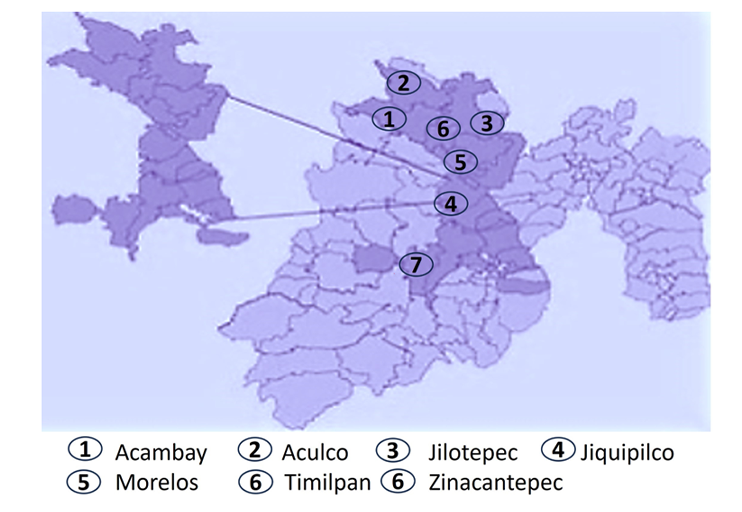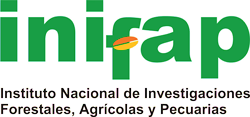The Otomi milpa (ra huähi hñähñu): agroecological biocultural heritage of the state of Mexico
DOI:
https://doi.org/10.29312/remexca.v16i4.3661Keywords:
food sovereignty, polyculture, traditional practices, ya k’aniAbstract
The industrial agrifood model has impacted on the peasant way of life and the traditional milpa system. For this reason, it was analyzed which elements currently make up the Otomi milpa and which remain in use; likewise, its social, ecological, and cultural perspectives in the field of food were discussed. The research was developed from a historical context, applying ethnographic techniques; two semi-structured interviews were designed and applied to twenty-eight peasant opinion leaders in seven municipalities of the High Valleys region of the state of Mexico. It is indicated that the milpa is a biocultural, sustainable, strategic, and broad construction that is integrated by traditional knowledge and practices, environmental complementarity, communality, and rituality. At present, it is still used and is vigorous and dynamic as a food source for indigenous and peasant families in the High Valleys; in addition, it safeguards the know-how that generates ecological balance and the reproduction of native corn, ya k’ani (native vegetables), and forage weeds. In perspective, the milpa is Otomis’s own alternative in the face of food, environmental, and health catastrophe; therefore, it can be revalued and strengthened by the new generations without violating its biocultural essence and putting its productive and ecological tradition first.
Downloads
References
Balcázar, Q. A.; White, O. L.; Chávez, M. C. y Zepeda, G. C. 2020. Los quelites: riqueza de especies y conocimiento tradicional en la comunidad otomí de San Pedro Arriba, Temoaya, Estado de México. Polibotánica. 49(25):219-242. Doi.org/10.18387/polibotanica.49.14.
Bartra, V. A. 2018. Campesindios. Aproximaciones a los campesinos de un continente colonizado. Boletín de Antropología Americana. México. 5-24 pp.
Cárdenas, M. A.; Vizcarra, B. I.; Espinoza, A. y Espinosa, C. A. 2019. Tortillas artesanales mazahuas y biodiversidad del maíz nativo. Reflexiones desde el ecofeminismo de la subsistencia. Sociedad y Ambiente. 1(19):265-291. https://doi.org/10.31840/sya.v0i19.1944.
Collin, H. L. 2021. La milpa como alternativa sustentable orientada al buen vivir. Scripta Ethnologica. Consejo Nacional de Investigaciones Científicas y Técnicas. 43:9-36. https://www.redalyc.org/journal/148/14869377001/.
Corona, L. J. y Maldonado, J. J. 2018. Investigación Cualitativa: enfoque Emic-Etic. Revista Cubana de Investigaciones Biomédicas. 37(4):1-4. http://scielo.sld.cu/scielo.php?script=sci-arttext&pid=S086403002018000400022&lng=es&.
Gámez, V. A.; De la O, O. M.; Santacruz, V. A. y López, S. H. 2014. Conservación in situ, manejo y aprovechamiento de maíz Palomero Toluqueño. Revista Mexicana de Ciencias Agrícolas. 5(8):1519-1530. http://www.scielo.org.mx/scielo.php?script=sci-arttext&pid=S200709342014000800015&lng=es&tlng=es.
Geertz, C. J. 2017. La interpretación de las culturas. Ed Gedisa. España. 19-40 pp. https://monoskop.org/images/c/c3/Geertz-Clifford-La-interpretacion-de-las-culturas.pdf.
González, M. M.; Petersen, P. F.; Garrido, P. F. y Caporal, C. F. 2021. Introducción de la agroecología política. Serie ambiente, cambio climático y sociedad. Colección grupos de trabajo. Consejo Latinoamericano de Ciencias Sociales (CLACSO). Argentina. 25-60 pp. https://www.clacso.org/wp-content/uploads/2022/01/Introduccion-agroecologia.pdf.
González, S. V. y Fernández, G. C. 2020. De la naturaleza a la mesa. Agricultura y saberes de campesinas de Huasca, Hidalgo, México. Revista de agroecología LEISA. 36(1)41-10.
INEGI. 2020. Instituto Nacional de Estadística y Geografía. Censo de población y vivienda 2020. Gobierno Federal. México. https://cuentame.inegi.org.mx/monografias/informacion/mex/poblacion/.
INPI. 2022. Instituto Nacional de los Pueblos Indígenas. Atlas de los pueblos indígenas de México. México: Gobierno federal. https://atlas.inpi.gob.mx/estado-de-mexico/.
Leyva, T. D.; Pérez, V. A.; Bezerra, C. I. y Formighieri, G. R. 2020. El papel de la milpa en la seguridad alimentaria y nutricional en hogares de Ocotal Texizapan, Veracruz, México. Polibotánica. 1(50):279-299. Doi.org/10.18387/polibotanica.50.16.
Linares, M. E. y Bye, B. R. 2015. Las especies subutilizadas de la milpa. Revista Digital Universitaria. 16(5):2-18. http://www.revista.unam.mx/vol.16/num5/art35/index.html.
Magdaleno, H. E.; Mejía, C. A.; Martínez, S. T.; Jiménez, V. M.; Sánchez, E. J. y García, C. J. 2016. Selección tradicional de semilla de maíz criollo. Agricultura, sociedad y desarrollo. 13(3):437-447. http://www.scielo.org.mx/scielo.php?script=sci-arttext&pid=S187054722016000300437&lng=es&tlng=es.
Mirafuentes, R. C. y Salazar, S. M. 2022. La Revolución Verde y la soberanía alimentaria como contrapropuesta. Revista Veredas. 42(22):106-129 https://veredasojs.xoc.uam.mx/index.php/veredas/article/view/660/618.
Morales, T. J. 2018. Evaluación productiva económica y productiva de los agrosistemas tradicionales de los hñahñus de Hidalgo en diferentes ambientes. Colegio de Postgraduados. Tesis de Maestría. Montecillos, Estado de México. 38-58 pp.
Osornio, A. M. 2022. Rescate de los saberes agrícolas tradicionales en los ñätho hñähñu. Revista Mexicana de Ciencias Agrícolas. 13(4):727-733. https://doi.org/10.29312/remexca.v13i4.3201.
Osornio, A. M. 2024. Faena, ayuda mutua y comunalidad en los Otomíes. Experiencia de conservación del ecosistema comunal. Educateconciencia. 32(2):42-58. Doi.org/10.58299/edutec.v31i42.716.
Peña, S. E. y Hernández, A. L. 2018. Biodiversidad, patrimonio y cocina. Procesos bioculturales sobre alimentación-nutrición, México. Secretaría de Cultura, Instituto Nacional de Antropología e Historia. 215-236 pp. https://doi.org/10.18234/secuencia.v0i0.1735.
Santiago, V. T.; García, M. M. y Rosset, P. M. 2018. Resiliencia y transformación agroecológica en el sur de México: validación y ajuste de un método participativo para fortalecer la resiliencia de sistemas campesinos. Agroecología. 11(2):23-30. https://revistas.um.es/agroecologia/article/view/330081.
Santiago, V. T.; Rosset, P. M.; Saldívar M. A.; Méndez, E. V. y Ferguson, G. B. 2021. La milpa: sistema de resiliencia campesina. Estudio de dos organizaciones campesinas en Chiapas. Región y sociedad. 33:e1432. https://doi.org/10.22198/rys2021/33/1432.
Soustelle J. E. 1993. La familia otomí-pame. Centro de Estudios Mexicanos y Centroamericanos. Fondo de Cultura Económica. México.
Vásquez, G. A.; Chávez, M. C.; Herrera, T. F. y Carreño, M. F. 2018. Milpa y seguridad alimentaria: el caso de San Pedro El Alto, México. Revista de Ciencias Sociales. RSC. 24(2):24-36.
Vincent, F. U.; Flores, S. D.; Navarro, G. H. y González, S. M. 2024. Transición agroecológica del Grupo Vicente Guerrero y su incidencia en tres comunidades vinculadas, Tlaxcala, México. Revista de Geografía Agrícola. 1(73):1-20. https://doi.org/10.5154/r.rga.2023.73.01.
Wrigth, C. C. 2005. El papel de los otomíes en las culturas del altiplano central: 5000 aC-1650 dC. Revista Arqueología Mexicana. 13(73):26-30. https://www.researchgate.net/publication/236111395-Lengua-cultura-e-historia-de-los-otomies.

Published
How to Cite
Issue
Section
License
Copyright (c) 2025 Revista Mexicana de Ciencias Agrícolas

This work is licensed under a Creative Commons Attribution-NonCommercial 4.0 International License.
The authors who publish in Revista Mexicana de Ciencias Agrícolas accept the following conditions:
In accordance with copyright laws, Revista Mexicana de Ciencias Agrícolas recognizes and respects the authors’ moral right and ownership of property rights which will be transferred to the journal for dissemination in open access. Invariably, all the authors have to sign a letter of transfer of property rights and of originality of the article to Instituto Nacional de Investigaciones Forestales, Agrícolas y Pecuarias (INIFAP) [National Institute of Forestry, Agricultural and Livestock Research]. The author(s) must pay a fee for the reception of articles before proceeding to editorial review.
All the texts published by Revista Mexicana de Ciencias Agrícolas —with no exception— are distributed under a Creative Commons License Attribution-NonCommercial 4.0 International (CC BY-NC 4.0), which allows third parties to use the publication as long as the work’s authorship and its first publication in this journal are mentioned.
The author(s) can enter into independent and additional contractual agreements for the nonexclusive distribution of the version of the article published in Revista Mexicana de Ciencias Agrícolas (for example include it into an institutional repository or publish it in a book) as long as it is clearly and explicitly indicated that the work was published for the first time in Revista Mexicana de Ciencias Agrícolas.
For all the above, the authors shall send the Letter-transfer of Property Rights for the first publication duly filled in and signed by the author(s). This form must be sent as a PDF file to: revista_atm@yahoo.com.mx; cienciasagricola@inifap.gob.mx; remexca2017@gmail.
This work is licensed under a Creative Commons Attribution-Noncommercial 4.0 International license.


